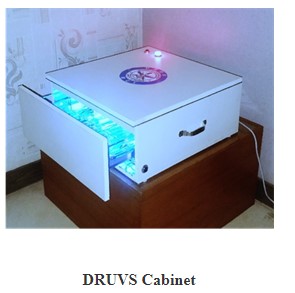Why in news?
Defence Research and Development Organisation (DRDO) has developed an automated contactless UVC sanitisation cabinet, called Defence Research Ultraviolet Sanitiser (DRUVS).
It has been designed to sanitise mobile phones, iPads, laptops, currency notes, cheque leafs, challans, passbooks, paper, envelopes, etc.
Details

- The DRUVS cabinet is having contactless operation.
- It provides 360-degree exposure of UVC to the objects placed inside the cabinet.
- The RCI has also developed an automated UVC currency sanitising device, called NOTESCLEAN.
- Bundles of currency notes can be sanitised using DRUVS, however disinfection of each currency notes using it will be a time consuming process.
- It picks the notes one by one and makes them pass through a series of UVC lamps for complete disinfection.
How does UV help in Disinfection and how is it better?

- UV light in the range of wavelengths between 200 and 300 nm is capable of inactivating microorganisms, such as bacteria and viruses, thus disinfecting both air and solid surfaces.
- Often, chemical disinfectants are not enough to remove the bacteria and viruses found in hospitals and other contamination prone environment.
- Rapid decontamination of the used patient-care beds and hospital rooms before admission of subsequent occupants is a major requirement in hospitals in view of the limited availability of beds.
- Coronavirus is sensitive to UVC light, as in the case of other viruses and bacteria.
- The germicidal effects of UVC irradiation with a peak intensity at 254 nm results in cellular damage of the virus, thereby inhibiting cellular replication.
- Unlike chemical approaches to disinfection, UV light provides rapid, effective inactivation of microorganisms through a physical process.



